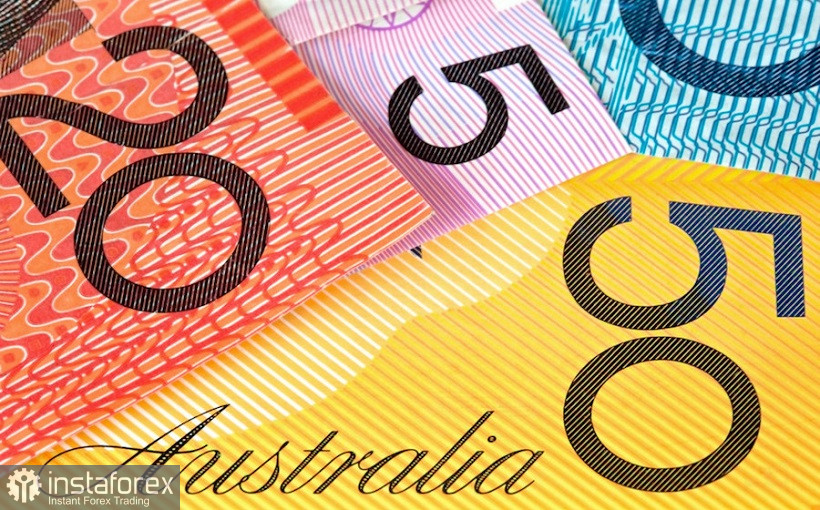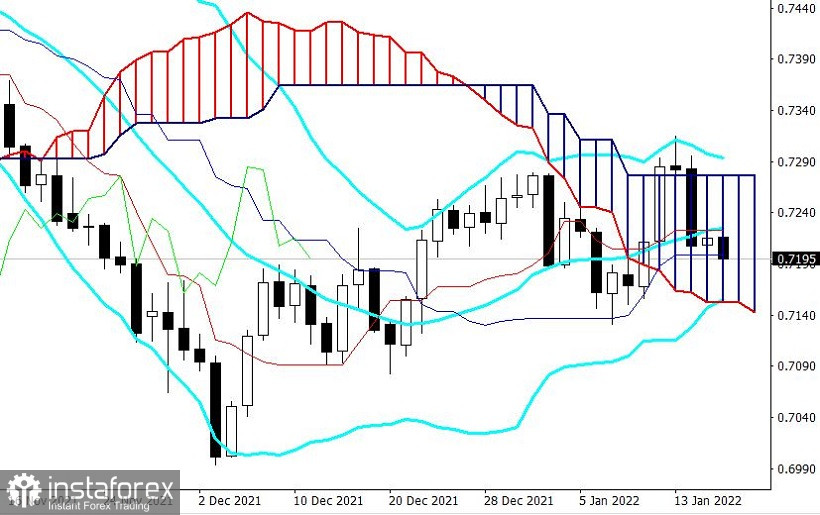The US dollar continues to gradually gain momentum, redrawing the outlook in the main dollar pairs. It follows the Treasury yields, which in turn, break multi-month records. In particular, the yield on 10-year government bonds reached an annual high (1.852%) today, reflecting the mood of investors regarding the Fed's further actions. Last week, just a few days before the announcement of the "silence mode", many Fed officials voiced "hawkish" comments. Some of them said that the first round of rate increases should be carried out in March, while others added that they expect three or four increases before the end of this year. In view of this, US stock indices came under pressure, while treasury yields began to gradually (but surely) grow.
Such a fundamental background allowed the AUD/USD bears to continue the downward movement. Last Friday, the pair declined by almost 100 points, but on Monday, it tried to develop a slight correction. The attempt failed: buyers temporarily slowed down the downward trend, rising only 10 points from Friday's low. During today's Asian session, the sellers took control of the market again.
In general, the Australian dollar has been moving in the wake of the US currency for a long time. Amid the US dollar's weakening, the AUD/USD bulls managed to hit a two-month high last week (0.7315), but as soon as the US dollar began to be in high demand, the Australian dollar retreated, following its American counterpart.
Nevertheless, there are certainly certain prerequisites for the strengthening of the Australian dollar. For example, the Australian feels quite confident in many cross-pairs (for example, AUD/NZD) as it receives background support from both the commodity market and China. In particular, spot prices for iron ore reached a three-month high last week after the release of a sharper-than-expected slowdown in China's consumer price growth. The fact that Chinese inflation is slowing has suggested that Beijing will increase its stimulus measures in the coming months to support the economy. In addition, there are rumors on the market that China will ease restrictions on steel production in the first quarter of this year.
It should also be noted that the Australian dollar receives some support from the Reserve Bank of Australia, albeit it's hard to call it "support": the RBA is unlikely to disappoint the supporters of the Australian dollar by announcing that it will end its asset purchase program in February, despite the risks associated with the spread of a new Omicron strain. It can be recalled that the Australian regulator has already postponed the next stage of reducing QE amid the spread of Delta, so when Omicron appeared, corresponding concerns arose on the market. However, RBA Governor Philip Lowe denied these rumors – according to him, the Central Bank will most likely complete the program within the previously agreed timeframe, that is, in February.
However, all of the above fundamental factors are actually not considered in the context of the AUD/USD pair. The US dollar takes the lead, while the Australian dollar is forced to be led, given the divergence of the positions of the Fed and the RBA. The Reserve Bank of Australia really intends to put an end to the QE issue next month, but the hawkishness of the Australian regulator ends here. According to a Reuters survey among economists, the RBA will raise the rate tentatively in the first half of 2023, but not before, although the markets are now pricing in a much earlier start of monetary policy tightening (summer of this year). Such inflated expectations could not support the Australian dollar. Moreover, Lowe denied the hawkish rumors, calling them "unrealistic", but traders continue to put the fact of the first rate increase in prices until the end of 2022.
In any case, the Fed looks more resolute on the issue of normalization and subsequent tightening of monetary policy parameters. Therefore, the AUD/USD pair shows growth only when the greenback allows it to do so. The Australian dollar does not have its own arguments for breaking the trend: the above fundamental factors are not able to restrain the onslaught of dollar bulls.
All this indicates the priority of short positions on the AUD/USD pair. It is advisable to use the upward corrective pullbacks for the pair as an excuse to enter into sales. Technically, the pair on the daily chart is located between the middle and upper lines of the Bollinger Bands indicator, as well as in the Kumo cloud and between the Tenkan-sen and Kijun-sen lines of the Ichimoku indicator. It is advisable to consider short positions after the bears consolidate below the intermediate support level of 0.7200 (the Kijun-sen line on D1). The main target in the medium term is the 0.7140 mark – this is the lower border of the Kumo cloud, coinciding with the lower line of the Bollinger Bands on the same timeframe.
 English
English 
 Русский
Русский Bahasa Indonesia
Bahasa Indonesia Bahasa Malay
Bahasa Malay ไทย
ไทย Español
Español Deutsch
Deutsch Български
Български Français
Français Tiếng Việt
Tiếng Việt 中文
中文 বাংলা
বাংলা हिन्दी
हिन्दी Čeština
Čeština Українська
Українська Română
Română

